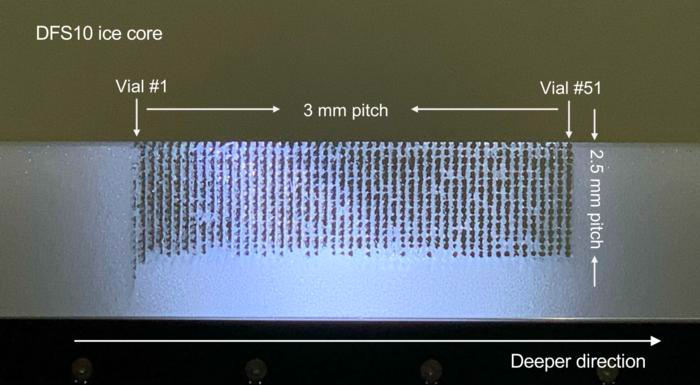Researchers from the Astro-Glaciology Laboratory at the RIKEN Nishina Center in Japan, led by Yuko Motizuki, have developed a new laser-based sample device for investigating the composition of glacier ice cores. The new technology has a 3-mm depth resolution, which is approximately three times smaller than what is currently available and can detect temperature differences that happened over considerably shorter periods of time in the past.
 A photograph showing discrete cylindrical holes after sampling (51 vials) a 15 cm-long section of a Dome Fuji shallow ice core (DFS10) drilled in East Antarctica. Image Credit: RIKEN
A photograph showing discrete cylindrical holes after sampling (51 vials) a 15 cm-long section of a Dome Fuji shallow ice core (DFS10) drilled in East Antarctica. Image Credit: RIKEN
The new laser melting sampler, or LMS, is intended to aid in reconstructing continuous yearly temperature variations that happened thousands to hundreds of thousands of years ago, allowing scientists to better understand past and contemporary climate change. On September 19th, 2023, the study was published in the Journal of Glaciology.
Tree rings can tell us how old a tree is, and the color and breadth of the rings can tell about the local environment at the time. The annual expansion of glaciers could tell a similar tale but over a far longer time span. Scientists are examining previous climate shifts by analyzing cylindrical ice cores extracted from glaciers.
Researchers can recreate continuous temperature profiles by sampling samples at regular intervals along the cores. This is difficult for samples collected from deep places, where yearly buildup is frequently compressed to sub-centimeters.
There are now two main procedures for sampling ice cores. One has a depth accuracy of around 1 cm, which implies that data from years with less than 1 cm accumulation are lost, and any one-time occurrences that significantly affected climate are missing.
The other approach offers high-depth precision, but it destroys the portion of the sample required to examine the water content–which is the major way scientists compute prior temperatures.
Both of these issues are addressed by the new laser melting sampler, which has excellent depth precision and does not damage the crucial oxygen and hydrogen isotopes found in water, which are required to infer previous temperatures.
The LMS system sends a laser beam through an optical fiber with a specific silver nozzle, swiftly extracting the liquid sample and putting it into stainless steel vials. After assembling the specialized gear, the researchers tested to optimize three essential aspects of the process: the amount of power for the laser, the pace at which the nozzle is inserted into the core as the laser melts the ice, and the rate at which the liquid sample is sucked out.
The optimization allowed the researchers to melt the ice as quickly as possible while preventing the laser from overheating and the meltwater from becoming too hot, which would destabilize the essential isotopes and preclude accurate temperature readings.
The researchers performed a proof-of-concept experiment by sampling a 15-cm piece of a 50-cm Dome-Fuji shallow ice core obtained around a football field (~92 m) below the ice surface in East Antarctica (see Movie). They were able to acquire 51 distinct samples at regular 3-mm intervals along the ice core length in one test.
They examined the stable oxygen and hydrogen isotopes in the meltwater collected from the samples and discovered that they matched well with those obtained by hand segmentation, a method that was only feasible in this research context. A strong match indicates that the laser-melting technique did not damage the sample and that the inferred temperatures are correct.
With our laser-melting method, it is now possible to analyze stable water isotopes at a few-millimeters depth resolution. This will allow researchers to obtain continuous, long-term, annually-resolved temperature profiles, even in deep ice cores collected at low accumulation sites in Antarctica, as well as transient events such as sudden temperature changes which are recorded in them.
Yuko Motizuki, Group Director, Astro-Glaciology Laboratory, RIKEN Nishina Center
The researchers want to utilize the LMS system, or an enhanced version of it, in the future to investigate climate change as it relates to natural oscillations in solar activity.
Journal Reference:
Motizuki, Y., et al. (2023) A novel laser melting sampler for discrete, sub-centimeter depth-resolved analyses of stable water isotopes in ice cores. Journal of Glaciology. doi:10.1017/jog.2023.52